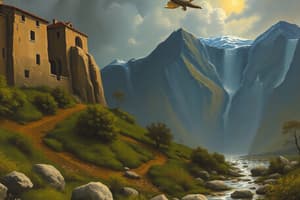Podcast
Questions and Answers
What is the primary driving force behind the movement of tectonic plates?
What is the primary driving force behind the movement of tectonic plates?
- Ocean currents
- Plate density differences
- Mantle convection (correct)
- Gravitational pull from the moon
Which of the following features is associated with divergent plate boundaries?
Which of the following features is associated with divergent plate boundaries?
- Deep ocean trenches
- Mountain ranges
- Mid-ocean ridges (correct)
- Island arcs
What type of plate boundary is characterized by the lateral sliding of plates?
What type of plate boundary is characterized by the lateral sliding of plates?
- Divergent boundary
- Transform boundary (correct)
- Convergent boundary
- Passive margin
Which phenomenon is responsible for the formation of volcanic arcs at ocean-ocean convergent boundaries?
Which phenomenon is responsible for the formation of volcanic arcs at ocean-ocean convergent boundaries?
Which property of minerals refers to how they break along planes of weakness?
Which property of minerals refers to how they break along planes of weakness?
What differentiates a hypothesis from a scientific theory?
What differentiates a hypothesis from a scientific theory?
Which of the following statements about the solar system is true?
Which of the following statements about the solar system is true?
What are the main components of the Earth's core according to Core Formation Theory?
What are the main components of the Earth's core according to Core Formation Theory?
Which observation type is described by measurable attributes?
Which observation type is described by measurable attributes?
What is the main difference between correlation and causation?
What is the main difference between correlation and causation?
What process explains the formation of the solar system through gravity and accretion?
What process explains the formation of the solar system through gravity and accretion?
What is the composition of the Earth's outer core?
What is the composition of the Earth's outer core?
Which scientist is well-known for the hypothesis of continental drift?
Which scientist is well-known for the hypothesis of continental drift?
What is a distinguishing characteristic of Pahoehoe lava?
What is a distinguishing characteristic of Pahoehoe lava?
What type of volcanic rock is characterized by its frothy, low density and light color?
What type of volcanic rock is characterized by its frothy, low density and light color?
What is a common feature of stratovolcanoes?
What is a common feature of stratovolcanoes?
Which process increases the surface area for chemical weathering?
Which process increases the surface area for chemical weathering?
What is the primary effect of volcanic gases in the stratosphere?
What is the primary effect of volcanic gases in the stratosphere?
What characterizes magma compared to lava?
What characterizes magma compared to lava?
Which type of igneous rock is formed from rapid cooling?
Which type of igneous rock is formed from rapid cooling?
What is a common volcanic eruption style associated with high-viscosity magma?
What is a common volcanic eruption style associated with high-viscosity magma?
Which intrusive igneous structure is characterized by vertical intrusion?
Which intrusive igneous structure is characterized by vertical intrusion?
What plays a significant role in determining the texture of igneous rocks?
What plays a significant role in determining the texture of igneous rocks?
Which process is responsible for melting at divergent boundaries?
Which process is responsible for melting at divergent boundaries?
What is a defining feature of mafic igneous rocks?
What is a defining feature of mafic igneous rocks?
According to Bowen’s Reaction Series, what influences mineral formation?
According to Bowen’s Reaction Series, what influences mineral formation?
Flashcards
Mantle Convection
Mantle Convection
Movement of the Earth's mantle, driving plate tectonics.
Tectonic Plate
Tectonic Plate
Large pieces of Earth's lithosphere, moving slowly.
Plate Boundary
Plate Boundary
Location where tectonic plates meet.
Convergent Boundary
Convergent Boundary
Signup and view all the flashcards
Mineral
Mineral
Signup and view all the flashcards
Heliocentric Model
Heliocentric Model
Signup and view all the flashcards
Big Bang Theory
Big Bang Theory
Signup and view all the flashcards
Terrestrial Planets
Terrestrial Planets
Signup and view all the flashcards
Jovian Planets
Jovian Planets
Signup and view all the flashcards
Differentiation (Earth)
Differentiation (Earth)
Signup and view all the flashcards
Earth's Core
Earth's Core
Signup and view all the flashcards
Plate Tectonic Theory
Plate Tectonic Theory
Signup and view all the flashcards
Pahoehoe Lava
Pahoehoe Lava
Signup and view all the flashcards
Aa Lava
Aa Lava
Signup and view all the flashcards
What are the two main types of weathering?
What are the two main types of weathering?
Signup and view all the flashcards
Differential Weathering
Differential Weathering
Signup and view all the flashcards
How does physical weathering help chemical weathering?
How does physical weathering help chemical weathering?
Signup and view all the flashcards
Magma vs. Lava
Magma vs. Lava
Signup and view all the flashcards
Divergent Boundaries
Divergent Boundaries
Signup and view all the flashcards
Intrusive Igneous Rocks
Intrusive Igneous Rocks
Signup and view all the flashcards
Extrusive Igneous Rocks
Extrusive Igneous Rocks
Signup and view all the flashcards
Mafic vs. Felsic
Mafic vs. Felsic
Signup and view all the flashcards
Effusive Eruption
Effusive Eruption
Signup and view all the flashcards
Explosive Eruption
Explosive Eruption
Signup and view all the flashcards
Decompression Melting
Decompression Melting
Signup and view all the flashcards
Study Notes
Geology
- Geology is the study of Earth's composition, structure, processes, and history.
Scientific Misconceptions
- Scientific principles involve understanding the difference between objective observation and subjective interpretation.
- Quantitative observations are measurable, while qualitative ones are descriptive.
- Correlation does not equal causation; an association does not imply cause and effect.
- A hypothesis is a testable prediction, while a scientific theory is a well-supported explanation of phenomena.
- Simpler explanations are favored unless more complexity is necessary (parsimony).
Observation vs. Interpretation
- Observation: Objective fact (e.g., "The rock is red").
- Interpretation: Explanation or inference (e.g., "The rock is red due to iron oxide").
Quantitative vs Qualitative Observations
- Quantitative: Measurable (e.g., "The rock weighs 5 kg").
- Qualitative: Descriptive (e.g., "The rock is smooth").
Correlation vs. Causation
- Correlation: Association
- Causation: One event causes another.
Hypothesis vs. Scientific Theory
- Hypothesis: Testable prediction.
- Theory: Well-supported explanation of phenomena.
Parsimony
- Simpler explanations are preferred unless more complexity is necessary.
Solar System
Heliocentric Model
- The current accepted model of the solar system places the Sun at the center.
Big Bang Theory
- The universe originated approximately 13.8 billion years ago and has been expanding ever since.
Sun Composition
- The Sun is primarily composed of hydrogen and helium.
Mass Distribution
- The Sun comprises roughly 99.8% of the solar system's total mass.
Meteorites
- Meteorites provide insights into the early solar system, originating from asteroids or planetary bodies.
Solar Nebular Theory
- The formation of the solar system involved a series of events:
- Nebula collapse
- Disk formation
- Proto-Sun heating (nuclear fusion begins)
- Planet formation (rocky planets closer to the Sun, gaseous planets farther out)
Terrestrial vs. Jovian Planets
- Terrestrial: Rocky planets (Mercury, Venus, Earth, Mars)
- Jovian: Gaseous planets (Jupiter, Saturn, Uranus, Neptune)
Moon's Origin
- The Moon formed from a massive impact with early Earth.
Water Hypotheses
- Water may have been delivered to Earth by comets and asteroids.
- Outgassing from Earth's interior could have also contributed to Earth's water.
Earth's Interior
Planetesimal Melting
- Heat from radioactive decay, impacts, and gravitational forces led to the melting of planetesimals.
Earth's Age
- Earth's age is approximately 4.54 billion years.
Differentiation
- Heavier elements (like iron) sank to form the core, while lighter materials rose to form the mantle.
Core Formation Theory
- The core is primarily composed of iron and nickel. Seismic wave studies and meteorite studies support this.
Compositional Layers
- Crust: Oceanic (thin, mafic) and Continental (thick, felsic)
- Mantle: Primarily composed of peridotite (ultramafic rock)
- Core: Outer (liquid) and Inner (solid)
Physical Layers
- Lithosphere: Rigid layer
- Asthenosphere: Plastic/ductile layer
- Mesosphere: Solid but high pressure layer
- Outer Core: Liquid, generates Earth's magnetic field.
- Inner Core: Solid.
Mantle Convection
- The solid mantle flows due to heat transfer.
Magnetic Field
- Convection in the liquid outer core generates Earth's magnetic field.
Plate Tectonic Theory
Key Scientists
- Alfred Wegener: Continental drift hypothesis (fossil, continental fit evidence).
- Arthur Holmes: Proposed mantle convection as a driving force.
- Marie Tharp: Seafloor mapping; confirmed seafloor spreading.
Tectonic Plates
- Plates comprise the lithosphere and are driven by mantle convection.
Evidence for Plate Tectonics
- Fossils (e.g., Mesosaurus)
- Magnetic polarity "barcodes" on the ocean floor
- Earthquake epicenters outline plate boundaries
- Seafloor spreading (young rocks near ridges, old rocks near continents)
- Hotspot ages indicate plate movement.
Plate Tectonic Boundaries
- Divergent: Plates move apart, new crust forms (Mid-Atlantic Ridge). Hazards: Volcanism, shallow earthquakes.
- Convergent: Plates collide, different types exist. Hazards = deep earthquakes, volcanoes, tsunamis.
- Ocean-Ocean: Island arcs, subduction (Trenches)
- Ocean-Continent: Continental arcs, subduction, trenches
- Continent-Continent: Mountain building (e.g., Himalayas)
- Transform: Plates slide laterally (e.g., San Andreas Fault). Hazards: Earthquakes, no volcanic activity.
Subduction Zones
- Denser oceanic plates sink beneath less dense continental or oceanic plates.
Ring of Fire
- Volcanoes around the Pacific occur due to subduction zones.
Passive Margins
- Not plate boundaries; no tectonic activity (e.g., East Coast USA)
Minerals
- Naturally occurring, inorganic, crystalline solids with a specific chemical composition.
Mineral Formation
- Cooling, evaporation, or high pressure/temperature conditions are required for mineral formation.
Crystal Habit
- Shape of crystals.
Polymorphs
- Same composition, different structures (e.g., diamond and graphite).
Common Elements in Crust
- Oxygen, silicon, aluminum, iron, etc.
Physical Properties of Minerals
- Color: Not reliably indicative due to impurities
- Streak: Color of mineral in powdered form (e.g., hematite streak = red)
- Luster: Metallic vs. non-metallic
- Hardness: Mohs scale (1 = talc, 10 = diamond).
- Cleavage: Breaks along planes (e.g., mica).
- Fracture: Irregular breakage (e.g., conchoidal fracture in quartz).
Studying That Suits You
Use AI to generate personalized quizzes and flashcards to suit your learning preferences.




